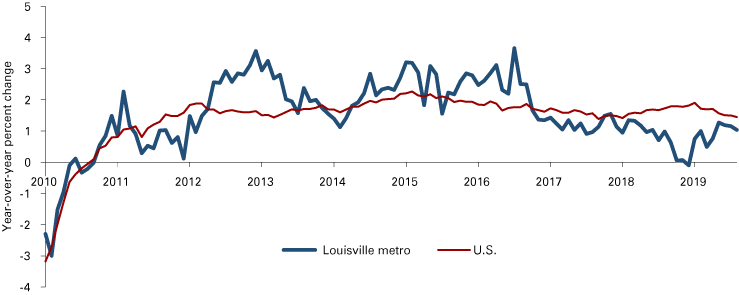Louisville forecast 2020

Executive Vice Chancellor for Academic Affairs and Sanders Chair in Business, Indiana University Southeast, New Albany
The outlook for 2019 was not on the overly optimistic side. Slower growth nationally and a continuation of local payrolls trailing the national pace were expected. During the last quarter of 2018, job gains in the Louisville metro came to a halt. This was the weakest quarter of payroll gains since 2010. Since then, job gains have resumed, but at a rate that continues to trail the national economy. The outlook for 2020 expects a pattern like 2019. Expect job creation for the Louisville metro to trail the nation, but with a higher rate now expected in Southern Indiana.
Louisville metro payrolls
For 2019, the Louisville metro will surpass job gains from 2018. The Louisville metro added approximately 5,000 jobs over the year in 2018, compared to about 7,600 jobs in 2019, based on a three-month rolling average of year-over-year payrolls. While we are seeing slight improvement from last year, the Louisville metro continues to lag national payroll growth (see Figure 1).
Figure 1: Year-over-year percent change in payroll jobs, January 2010 to August 2019

Source: Factset
Sector growth
Despite a weaker national manufacturing environment, 2019 showed some improvement for the Louisville metro. Manufacturing job growth was exceeding overall job growth and on pace to beat last year. However, the second half of 2019 showed a rapid decline in manufacturing payrolls. Based on current national indicators in manufacturing, this sector is not expected to contribute to significant job gains for 2020.
The strongest sector was education and health services, adding almost 3,000 jobs since last year. Mining, logging and construction also showed strong percentage gains, with an absolute change of approximately 2,000 jobs. Leisure and hospitality emerged from losses early in the year to positive territory. The professional and business services sector has been shedding jobs for the entire year, down approximately 2,000 since last year. Retail job growth began to trail overall job growth in the beginning of 2018. It has been under overall payroll growth since then, and registered negative changes through all of 2019. This is counter to the strong retail gains of 2016 through 2017 (see Figure 2).
Figure 2: Year-over-year percent change in payroll jobs for selected Louisville metro sectors, January 2016 to August 2019

Source: Factset
Stronger job growth in 2020 will be linked to the success of professional and business services. Watch this sector for early clues on the ultimate record for 2020.
Southern Indiana
Payroll growth in Southern Indiana (including Clark, Floyd, Harrison, Scott and Washington counties) just about came to a stall in 2018, registering job growth that was the weakest since 2011 (see Figure 3). Clark County showed a decline in job changes for the first two quarters of 2018 and weak positive changes in the last two quarters. The impressive job changes of a few years ago came with strong growth in Clark County, and this strength was absent in 2018. The good news is that the first quarter of 2019 (the most recent data available) is showing some promise. Southern Indiana added almost 2,000 jobs, and this is the strongest quarter since 2016. Clark County has emerged from the negative job changes of 2018 into positive territory, adding a little more than 1,000 jobs. This outlook expects more upside growth for Southern Indiana. While challenges remain with respect to labor force growth, economic development expansion will continue to fuel Southern Indiana growth.
Figure 3: Change in Southern Indiana and Clark County payroll jobs, 2009 Q1 to 2019 Q1

Source: STATS Indiana, using Quarterly Census of Employment and Wages data from the U.S. Bureau of Labor Statistics
Labor force and employment
Labor force data show that the labor force and employment continue to show limited growth. Year-over-year growth in both dipped below zero this year (see Figure 4). Reports from workforce development personnel and business owners continue to point to the lack of an available workforce. Limited growth in the labor force will continue to serve as headwinds to overall job growth.
Figure 4: Southern Indiana labor force and employment, January 2010 to August 2019

Source: Factset
Building permits
Building permits for the Louisville metro saw a small decline from 2017 to 2018. For 2019, Louisville metro permits are on track to reach about the same level of permits in 2018. Clark County saw a 40 percent increase in permits from 2017 to 2018, and September 2019 permits have already exceeded permits from the previous year. While we acknowledge labor force challenges for the region, building permit activity in Clark County points to a positive sign for such growth.
Summary and general outlook
Last year’s outlook expected an overall moderation in growth for the Louisville metro and at a rate that continued to trail national growth. That continues to materialize. Current national indicators do not point to stronger growth locally, and so we will see another year of moderate payroll growth. A weaker manufacturing environment nationally does not portend manufacturing growth locally. I do expect growth in Southern Indiana to pick up compared to recent years. The ability of the region to grow services, particularly professional and business services, will play a large role in the ultimate record for 2020.



